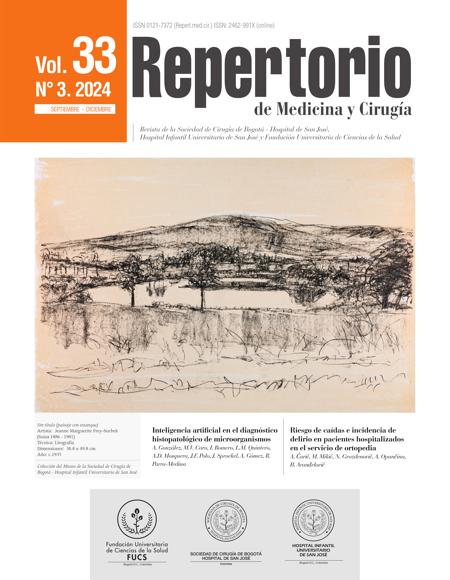Patología placentaria en restricción del crecimiento fetal y trastornos hipertensivos del embarazo
Pathology of the placenta in hypertensive disorders of pregnancy and fetal growth restriction
Esta obra está bajo una licencia internacional Creative Commons Atribución-NoComercial-CompartirIgual 4.0.
Mostrar biografía de los autores
Introducción: los trastornos hipertensivos del embarazo y la restricción del crecimiento fetal son patologías de gran impacto, compartiendo el origen fisiopatológico en la placentación anómala. El estudio histológico de la placenta permite comprender parte de estos fenómenos, además de tener implicaciones académicas, médicas y legales. Objetivo: caracterizar los hallazgos anatomopatológicos en placentas de madres con diagnóstico de trastornos hipertensivos del embarazo y/o restricción del crecimiento fetal, en un hospital de alta complejidad de Popayán, Colombia. Métodos: estudio observacional de corte transversal, la población fue de pacientes con restricción del crecimiento fetal y/o trastornos hipertensivos del embarazo diagnosticadas entre 2019 y 2020, con estudio anatomopatológico de la placenta. Resultados: se analizaron 155 casos con hallazgos de malperfusión vascular materna 99.35%, malperfusión vascular fetal 70.97%, maduración tardía de las vellosidades 4.52% e inflamación 41.35%. Conclusiones: el presente estudio reveló alta prevalencia de hallazgos histopatológicos anormales acercándose a lo reportado en la literatura.
Visitas del artículo 459 | Visitas PDF 251
Descargas
- World Health Organization. Objetivos de Desarrollo Sostenible: Metas. World Health Organization; 2015 [cited 2019 Dec 4]; Available from: https://www.who.int/data/gho/data/themes/world-health-statistics
- Martínez Sánchez LM, Rodríguez Gázquez ÁM, Mejía Ruiz C, Hernández Restrepo F, Quintero Moreno DA, Gómez Arango L. Perfil clínico y epidemiológico de pacientes con trastorno hipertensivo asociado al embarazo en Medellín, Colombia. Revista Cubana de Obstetricia y Ginecología. 2018;44(2):1-9.
- Bokslag A, Weissenbruch MV, Mol BW, M de Groot CJ. Preeclampsia; short and long-term consequences for mother and neonate. Early Hum Dev. 2016;102:47–50. https://doi.org/10.1016/j.earlhumdev.2016.09.007. DOI: https://doi.org/10.1016/j.earlhumdev.2016.09.007
- American College of Obstetricians and Gynecologists', Committee on Practice Bulletins Obstetrics and the Society forMaternal-FetalMedicin. ACOG Practice Bulletin No. 204: Fetal Growth Restriction. Obstet Gynecol. 2019;133(2):e97–109. https://doi.org/10.1097/AOG.0000000000003070. DOI: https://doi.org/10.1097/AOG.0000000000003070
- Verdugo-Muñoz LM, Alvarado-Llano JJ, Bastidas-Sánchez BE, Ortiz-Martínez RA. Prevalencia de restricción del crecimiento intrauterino en el Hospital Universitario San José, Popayán (Colombia), 2013. Rev. Colomb. Obstet. Ginecol. 2015;66(1):46-2. https://doi.org/10.18597/rcog.7 DOI: https://doi.org/10.18597/rcog.7
- Alonso-Remedios A, Pérez-Cutiño M, de León Delgado DF. Inmunopatogenia de la enfermedad hipertensiva gravídica. Rev Cuba Obstetr Ginecol. 2018;43(4):10-114
- Turco MY, Moffett A. Development of the human placenta. Development. 2019;146(22):dev163428. https://doi.org/10.1242/dev.163428. DOI: https://doi.org/10.1242/dev.163428
- Langston C, Kaplan C, Macpherson T, Manci E, Peevy K, Clark B, et al. Practice guideline for examination of the placenta: developed by the Placental Pathology Practice Guideline Development Task Force of the College of American Pathologists. Arch Pathol Lab Med. 1997;121(5):449–76.
- Prieto-Gómez R, Ottone NE, Sandoval-Vásquez C, Saavedra-S A, Bianchi HF. Aspectos morfocuantitativos de las vellosidades coriales libres en gestas normales, con diabetes, hipertensión arterial y restricción del crecimiento intrauterino. Int. J. Morphol. 2018;36(2):551-556. http://dx.doi.org/10.4067/S0717-95022018000200551 DOI: https://doi.org/10.4067/S0717-95022018000200551
- Khong TY, Mooney EE, Ariel I, Balmus NCM, Boyd TK, Brundler M-A, et al. Sampling and Definitions of Placental Lesions: Amsterdam Placental Workshop Group Consensus Statement. Arch Pathol Lab Med. 2016;140(7):698–713. http://dx.doi.org/10.5858/arpa.2015-0225-CC. DOI: https://doi.org/10.5858/arpa.2015-0225-CC
- Gordijn, S.J., Beune, I.M., Thilaganathan, B., Papageorghiou, A., Baschat, A.A., Baker, P.N., Silver, R.M., Wynia, K. and Ganzevoort, W. Consensus definition of fetal growth restriction: a Delphi procedure. Ultrasound Obstet Gynecol, 2016;48(3):333-339. http://dx.doi.org/10.1002/uog.15884. DOI: https://doi.org/10.1002/uog.15884
- Brown MA, Magee LA, Kenny LC, Karumanchi SA, McCarthy FP, Saito S, Hall DR, Warren CE, Adoyi G, Ishaku, S. The hypertensive disorders of pregnancy: ISSHP classification, diagnosis & management recommendations for international practice. Hypertension. 2018;72(1):24-43. http://dx.doi.org/10.1161/HYPERTENSIONAHA.117.10803. DOI: https://doi.org/10.1161/HYPERTENSIONAHA.117.10803
- Thompson JM, Irgens LM, Skjaerven R, Rasmussen S. Placenta weight percentile curves for singleton deliveries. BJOG. 2007;114(6):715–720. http://dx.doi.org/10.1111/j.1471-0528.2007.01327.x. DOI: https://doi.org/10.1111/j.1471-0528.2007.01327.x
- Eskild A, Haavaldsen C, Vatten LJ. Placental weight and placental weight to birthweight ratio in relation to Apgar score at birth: a population study of 522 360 singleton pregnancies. Acta Obst Gynecol Scand. 2014;93(12):1302–1308. http://dx.doi.org/10.1111/aogs.12509. DOI: https://doi.org/10.1111/aogs.12509
- Sehgal A, Dahlstrom JE, Chan Y, Allison BJ, Miller SL, Polglase GR. Placental histopathology in preterm fetal growth restriction. J Paediatr Child Health. 2019;55(5):582-587. http://dx.doi.org/10.1111/jpc.14251. DOI: https://doi.org/10.1111/jpc.14251
- Sánchez-Cobo D, Copado-Mendoza DY, Valdespino-Vázquez MY, Rodríguez-Sibaja MJ, Acevedo-Gallegos S. Cambios morfológicos en las placentas de pacientes con preeclampsia o restricción del crecimiento intrauterino e interpretación de los desenlaces perinatales. Ginecol Obstet Méx. 2021;89(11):875-883. https://doi.org/10.24245/gom.v89i11.4944. DOI: https://doi.org/10.24245/gom.v89i11.4944
- Fillion A, Guerby P, Menzies D, Lachance C, Comeau MP, Bussières MC, Bujold E. Pathological investigation of placentas in preeclampsia (the PEARL study). Hypertens Pregnancy. 2021;40(1):56–62. https://doi.org/10.1080/10641955.2020.1866008. DOI: https://doi.org/10.1080/10641955.2020.1866008
- Levy M, Kovo M, Schreiber L, Kleiner I, Koren L, Barda G, Weiner E. Pregnancy outcomes in correlation with placental histopathology in subsequent pregnancies complicated by preeclampsia. Pregnancy Hypertens. 2019;18:163–168. http://dx.doi.org/10.1016/j.preghy.2019.09.021. DOI: https://doi.org/10.1016/j.preghy.2019.09.021
- Ditisheim A, Sibai B, Tatevian N. Placental Findings in Postpartum Preeclampsia: A Comparative Retrospective Study. Am J Perinatol. 2020;37(12):1217-1222. http://dx.doi.org/10.1055/s-0039-1692716. DOI: https://doi.org/10.1055/s-0039-1692716
- Weiner E, Schreiber L, Grinstein E, Feldstein O, Rymer-Haskel N, Bar J, Kovo M. The placental component and obstetric outcome in severe preeclampsia with and without HELLP syndrome. Placenta. 2016;47:99–104. http://dx.doi.org/10.1016/j.placenta.2016.09.01. DOI: https://doi.org/10.1016/j.placenta.2016.09.012
- Hwa Im D, Kim YN, Cho HJ, Park YH, Kim DH, Byun JM, Sung MS. Placental Pathologic Changes Associated with Fetal Growth Restriction and Consequent Neonatal Outcomes. Fetal Pediatr Pathol. 2021;40(5):430-441. http://dx.doi.org/10.1080/15513815.2020.1723147. DOI: https://doi.org/10.1080/15513815.2020.1723147
- Yaguchi C, Itoh H, Tsuchiya KJ, Furuta-Isomura N, Horikoshi Y, Matsumoto M, Kanayama N. Placental pathology predicts infantile physical development during first 18 months in Japanese population: Hamamatsu birth cohort for mothers and children (HBC Study). Plos One, 2018;13(4):e0194988. http://dx.doi.org/10.1371/journal.pone.0194988. DOI: https://doi.org/10.1371/journal.pone.0194988
- Ueda M, Tsuchiya KJ, Yaguchi C, Furuta-Isomura N, Horikoshi Y, et al. Placental pathology predicts infantile neurodevelopment. Sci Rep. 2022;12(1):2578. http://dx.doi.org/10.1038/s41598-022-06300-w. DOI: https://doi.org/10.1038/s41598-022-06300-w













